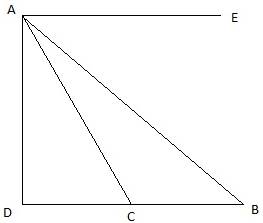As observed from the top of a lighthouse, 100 m above sea level, the angle of depression of a ship, sailing directly towards it, changes from 30° to 60°. Determine the distance travelled by the ship during the period of observation. [Use √3 = 1.732.]

In the above figure, let AD be the lighthouse and B and C be the two consecutive positions of the ship in view from it. The top of the lighthouse is 100 m above sea level. So, AD = 100 m. Also given that the angles of depression of the ship from the point A at the positions B and C are 30° and 60° respectively. Join D, C, B. Also join B, C to A. Then we get two right angled triangles ABD and ACD with right angles at D. Now, draw a line AE parallel to the sea level. Then, ∠EAB = ∠ABD = 30° and ∠EAC = ∠ACD = 60°. We are to find the distance travelled by the ship during the period of observation, that is, BC. We just use the trigonometric ratio tan from triangles ABD and ADC to find DB and DC respectively.
From ∆ACD,
![]()
or,
![]()
Again, from ∆ABD,
![]()
or,
![]()
or,
![]()
Hence, distance travelled by ship during the observation is
![]()